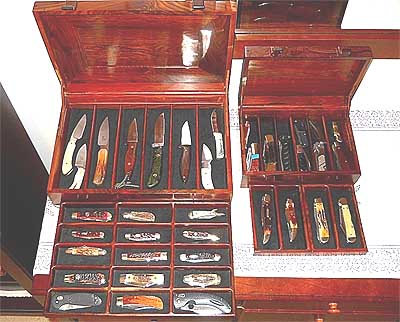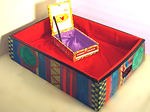HOW - TO CORNER:
What ever you collect, there are some simple and elegant ways to highlight your collection. You can usually use simple tools to build your own display items that both protect your stuff, and show it off with museum-like elegance. For example, meticulously embedding your collection in velvet helps the world, -or at least your spouse- finally appreciate it’s real value. I have tired to offer advice that can be used by any collector, whether he or she buys casework from me or not. You may need, however, to use a little ingenuity to apply these suggestions to the stuff you picked up at the super-store to work as well as they would work with casework designed especially for collectors.
Museums of the World:
![]() I offer this site as a teacher rather than a (self-proclaimed) expert in amateur curatorial techniques. Museums of the Worlds an educational site and offers links to some wonderful museum sites: the Louvre, the Smithsonian etc. (No idea what Amazon is in doing on the list, but whad'ya gon'na do?).
I offer this site as a teacher rather than a (self-proclaimed) expert in amateur curatorial techniques. Museums of the Worlds an educational site and offers links to some wonderful museum sites: the Louvre, the Smithsonian etc. (No idea what Amazon is in doing on the list, but whad'ya gon'na do?).
Why We Collect
I'm particularly proud to be able offer Daniel Arnet's thoughts on Why We Collect. Reprinted with kind permission of the author and Hemispheres -the magazine of United Airlines.
Amass
Appeal
By
Richard Rubin,
Reprinted
w/ kind permission from AARP Magazine
March / April issue of 2008
More Thoughts on Knives and Collecting -from the guys at iKnife.
I didn't so much write this article as edited what a lot of GOBs from the iKnife web-site had to say about preserving and protecting their knife collections. Got some great advice.
Padded Display Panels:
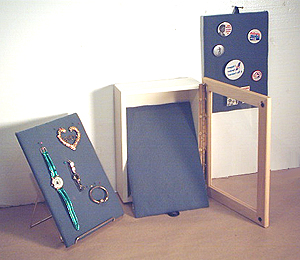 I make these for some of my shadow boxes. They are for putting pictures and smallish things and what-not in the background of a nice little display. But they don't have to go in a box. They work nicely hanging on the wall or on a stand on the piano! Here is an easy way to make your own.
I make these for some of my shadow boxes. They are for putting pictures and smallish things and what-not in the background of a nice little display. But they don't have to go in a box. They work nicely hanging on the wall or on a stand on the piano! Here is an easy way to make your own.
For a short video on the subject, check out....
Lining Drawers with Fabric:
One more method of making your collection look like a COLLECTION. Lining the drawers it lives in with fabric. Here is a fairly pain-free way of tailoring fabric to drape elegantly into your drawers. And NO sewing is necessary!
Riker Mounts Mk II
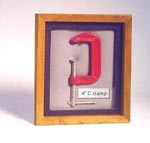
The nuts & bolts of getting your collectable to stay where you put it in a Riker-mount and then How-To show it off on the wall. (For the art & design of displaying your collections, check out Riker-mounts Mk 1)
Organizing the Large Collection
 What to do about the sprawling mess of wonderful items? Your spouse insists it's a bunch of junk and you know it's an important collection. Here are some thoughts on organizing it all to the point you can prove it's a real collection.
What to do about the sprawling mess of wonderful items? Your spouse insists it's a bunch of junk and you know it's an important collection. Here are some thoughts on organizing it all to the point you can prove it's a real collection.
Easy Home-Made Drawer Dividers for your Collection
 I understand the urge to do something to prevent a mess of collectable pens, jewelry, coins, knives, or marbles, etc. rolling around in the bottom of an otherwise lovely drawer like…. well…. like marbles. Here is a brief & easy HOW-TO on making compartmented drawer dividers / liners for your collections
I understand the urge to do something to prevent a mess of collectable pens, jewelry, coins, knives, or marbles, etc. rolling around in the bottom of an otherwise lovely drawer like…. well…. like marbles. Here is a brief & easy HOW-TO on making compartmented drawer dividers / liners for your collections
Photographing your Collection
 Whether it's pretty and you want to show people, or it's valuable and you need to prove it, there are some good reasons to photograph your collection. Here are some tips to doing it easily and professionally.
Whether it's pretty and you want to show people, or it's valuable and you need to prove it, there are some good reasons to photograph your collection. Here are some tips to doing it easily and professionally.
The Demographics and Statistics of Hobbies:
 So who spends what on their hobby, do men or women spend more, and how old are they when they do the this spending? What hobbies? Find some of the answers here. And what I don't know, I make up.
So who spends what on their hobby, do men or women spend more, and how old are they when they do the this spending? What hobbies? Find some of the answers here. And what I don't know, I make up.
TOP 10 ways to Help your Kids Collect:
 I'd like to take credit for this article, but I can't. It's from a wonderful site about doing stuff with your kids. And I mean things kids actually might WANT to do! If you have kids, or have any dealing with kids, or know how to spell KIDS, you must check out Dad-Can-Do.
I'd like to take credit for this article, but I can't. It's from a wonderful site about doing stuff with your kids. And I mean things kids actually might WANT to do! If you have kids, or have any dealing with kids, or know how to spell KIDS, you must check out Dad-Can-Do.
CHILDREN and Collecting:
Collecting bugs, rocks, leaves, baseball cards, stamps, coins, or who-knows-what is apart of childhood. Here are some thoughts on how to make it educational too!
Cleaning Fine Collectables and Antiques Part I: -What to Use
 Isn't there a book out that will tell you how to clean ANYTHING? This ain't it, but I do have some advice on just what to use to get-'er done -without destroying a priceless do-dad.
Isn't there a book out that will tell you how to clean ANYTHING? This ain't it, but I do have some advice on just what to use to get-'er done -without destroying a priceless do-dad.
Cleaning Fine Collectables and Antiques Part II: -How-To
 Once you have gathered up just the right tools'n stuff to do it (almost) like the pros do it, here is HOW the pros do it -to SPECIFIC artifacts.
Once you have gathered up just the right tools'n stuff to do it (almost) like the pros do it, here is HOW the pros do it -to SPECIFIC artifacts.
Collecting for Profit: Collections as Investment Vehicles.
 Is your collection going to put your kids through school, let you retire graciously, and cure cancer?
Is your collection going to put your kids through school, let you retire graciously, and cure cancer?
The Psychology of Collecting:
 Where-in the Author explores collectors in four flavors: the Clinical, the Nut-Case, the Victim, and the Accidental Collector.
Where-in the Author explores collectors in four flavors: the Clinical, the Nut-Case, the Victim, and the Accidental Collector.
Advanced Shadow Boxing:
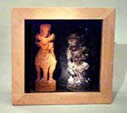 Showmanship is the keyword here. Lighting, color, and composition can make all the difference.
Showmanship is the keyword here. Lighting, color, and composition can make all the difference.
Some thoughts on PRESERVATION:
Here are some ways for the collector to protect their collection with museum-like professionalism.
I don't suppose King Tut's solid gold headpiece is any more valuable to you then your son's or daughter's first winning soccer jersey. But King Tut has all manner of people -people with all manner of initials behind their names- tending to all manner of threats. These threats include things like UV light, atmospheric nastinesses, vile little creatures that creep, crawl, & eat, and -last but not least- bad people who would steal the king's goodies.
If you don't have fancy initials behind your name, not to worry, nor do I, but I have taken upon myself the task of talking to a few such people and read some really REALLY hard stuff these people wrote. Stuff with tables & graphs & Greek letters fer-goodness-sake! On more then one occasion I remembered all too clearly my old high school chemistry and physics classes. Can't say I remembered any chemistry or physics, I just remembered being confused in particularly chemical and physical ways. Things like oxidation, frequency, & wavelengths of light and other such imponderables. But now I have some good and -let us hope -comprehensive- advice to pass on to you.
The following video is from a talk I gave at the Denver Brass Armadillo
on the topic of Preservation of Paper & Fabric. Kind'a fun. Check it out.
Bio-hazards
 What do do about the vile little things that eat valuable collectibles.
What do do about the vile little things that eat valuable collectibles.Security
 What to do about the vile people who might want to steal your collection -or just borrow it for a long time..
What to do about the vile people who might want to steal your collection -or just borrow it for a long time..
Archival Materials
 Sometimes the things you might use to protect your collection might actually do damage. Here is some advice on acid free and archival safe materials.
Sometimes the things you might use to protect your collection might actually do damage. Here is some advice on acid free and archival safe materials.
Desiccants
 Perhaps the first step to preserve your valuable collection is to KEEP ITT DRY. Here's how.
Perhaps the first step to preserve your valuable collection is to KEEP ITT DRY. Here's how.
Light & Radiation
 One of the biggest threats to certain collectibles is nothing more then the stuff we use to see it! Here is how to prevent light from fading or degrading your collection.
One of the biggest threats to certain collectibles is nothing more then the stuff we use to see it! Here is how to prevent light from fading or degrading your collection.
Fabric
 Nice soft padding will protect your most valuable items? Maybe not. Here is how to select the right fabric.
Nice soft padding will protect your most valuable items? Maybe not. Here is how to select the right fabric.
Gift Giving for the Collector in Your Life
There is something special about gifts that lead to the gifter and giftie spending time and doing something together. And if this something benefits the giftie's hobby or collection, we have a wonderful and memorable gift. (And if it tidies up the clutter, so much the better for all concerned.) 
Last Minute Gifts for the Collector -and for Kid Collectors too!
What to do about your spouse or child who insist on bringing home every what'sits he or she can lay hands on? And what to do in the weeks before the holidays? Put yourself into the mind of the collector and use a little imagination and you can pull off a terrific gift for next to nothing.
Easy Home-made DISPLAY STANDS |
|||||
 So you say you have something that is special and beautiful but it just sort of sits there? Perhaps it needs it's own display stand. Here is an easy way to make something simple and EXACTLY the right size, shape and color.
So you say you have something that is special and beautiful but it just sort of sits there? Perhaps it needs it's own display stand. Here is an easy way to make something simple and EXACTLY the right size, shape and color.
Beginning Display Stands -Video #1
Advanced Display Stands -Video #2
Faux Finish (for display-stands)
Riker Mounts
How to use them to easily high-light your collection:
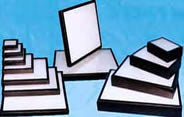 Riker mounts are the easiest possible way to protect and show-off your collection of smallish items. Simple elegant boxes, -padded inside and with a tempered glass window.
Riker mounts are the easiest possible way to protect and show-off your collection of smallish items. Simple elegant boxes, -padded inside and with a tempered glass window.
Displaying Collectable Athletic Jerseys,
Your hero's or your own:
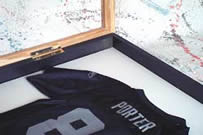 Where-in I explore how to go about displaying the numbers in the manner they deserve. Whether it's from the Super-Bowl, or you kids soccer jersey.
Where-in I explore how to go about displaying the numbers in the manner they deserve. Whether it's from the Super-Bowl, or you kids soccer jersey.
A Visit to the Fabric Store
 In witch we learn that even a ham-fisted cabinet maker can understand and do lovely things with cloth to display and protect collectibles.
In witch we learn that even a ham-fisted cabinet maker can understand and do lovely things with cloth to display and protect collectibles.
FAUX FINISHING and CASEWORK:
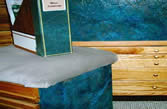 There are some great ways to make even ugly old particle board look beautiful. And it you do it this way, it's quick and easy. It's also a great way to dress up things that are old and ugly -but not quite antiques!
There are some great ways to make even ugly old particle board look beautiful. And it you do it this way, it's quick and easy. It's also a great way to dress up things that are old and ugly -but not quite antiques!
Faux Finishing Techniques
FRENCH LINING DRAWERS:
No matter how oddly shaped or fragile the items in your collection, here is a technique you can use to make drawer linings that perfectly match your stuff, -and do so with only the tools in your kitchen and a few simple supplies.
ADAPTABLE DRAWER LININGS:
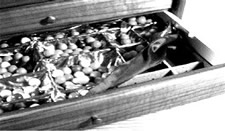 While a drawer with a French lining is fixed for permanent collections, some collections are growing and changing. Adaptable linings are called for in this instance. Here’s how to make an adaptable -compartmented drawer lining that you can chance with your collection.
While a drawer with a French lining is fixed for permanent collections, some collections are growing and changing. Adaptable linings are called for in this instance. Here’s how to make an adaptable -compartmented drawer lining that you can chance with your collection.
PART 1 Designing Custom Display Cabinets
PART 2 Building Custom Display Cabinets
 The smallest and most delicate collections may well belong in drawers. Bigger things need to be displayed, perhaps on a pedestal. Somewhere in between however, are those things that want to go into display cases, -on the wall, behind glass even. Here is how to go about getting yourself custom display cases.
The smallest and most delicate collections may well belong in drawers. Bigger things need to be displayed, perhaps on a pedestal. Somewhere in between however, are those things that want to go into display cases, -on the wall, behind glass even. Here is how to go about getting yourself custom display cases.
Displaying A Knife Collection, Part I, on the Wall:
 Arguably knife making is mankind's first art. Beautiful things, knives. So beautiful that they deserve a special display. With one of my cases -or one of your own- you can build a custom museum piece. Or for the collection that wants to be tucked safely away in a drawer, French lining drawers is a great approach.
Arguably knife making is mankind's first art. Beautiful things, knives. So beautiful that they deserve a special display. With one of my cases -or one of your own- you can build a custom museum piece. Or for the collection that wants to be tucked safely away in a drawer, French lining drawers is a great approach.
Displaying A Knife Collection, Part 2, on the Flat:
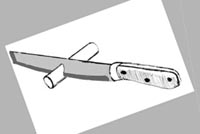 In Displaying a Knife Collection above, I offer advice on displaying knives on the wall. Nice way to go, but what if you wanted to put them in a display case on the flat, or perhaps one of my coffee table display cases -under glass even? Here is a great technique to display your knives on a flat surface and protect the edges at the same time.
In Displaying a Knife Collection above, I offer advice on displaying knives on the wall. Nice way to go, but what if you wanted to put them in a display case on the flat, or perhaps one of my coffee table display cases -under glass even? Here is a great technique to display your knives on a flat surface and protect the edges at the same time.
Hanging Things on the Wall CORRECTLY:
If you spend some time on a nice shadowbox, or put cherished collectibles in a display case, you MUST hang it on the wall correctly. Here's how.
The Collector and Hobbyist's Toolbox:
 So what do you need to have on-hand to be able to fiddle about with your collection? For that matter, what do you need on-hand to get to the bottom of your TO-DO list? Have a look here to find out and get an idea what it will cost you. (And if you aren't a do-it-yourself kind'a person check out the next article.)
So what do you need to have on-hand to be able to fiddle about with your collection? For that matter, what do you need on-hand to get to the bottom of your TO-DO list? Have a look here to find out and get an idea what it will cost you. (And if you aren't a do-it-yourself kind'a person check out the next article.)
HIRING CARPENTERS ....and other useful things.
Hey, lets face it, even museum professionals hire carpenters and/or cabinet makers. Here is how to get exactly what you want, and get the most for your money.
SHADOW BOXES
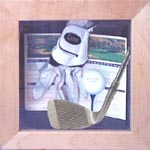 Enjoy a wonderful old fashioned hobby that does scrap-books one better. You can easily showcase your heirlooms in classic shadow boxes or other displays. Here's how.
Enjoy a wonderful old fashioned hobby that does scrap-books one better. You can easily showcase your heirlooms in classic shadow boxes or other displays. Here's how.
Shadow Boxes for Kids
Shadow Boxes, Beginning Session from gotchavideos on Vimeo.
The following five articles are for my products -particularly my architectural casework. None the less, there is value to the collector of hobbyist who is building a Home-Museum from any casework etc. |
Design & Build Desks & Counters
 Think of my Architectural Drawer Cases as big building blocks. (This is the way I designed them after all !) If they are blocks, it should be easy to stack them up into interesting and useful shapes, shouldn't it? Indeed so. Here is how to do a professional job. (This is a longish article -give it a minute to download.)
Think of my Architectural Drawer Cases as big building blocks. (This is the way I designed them after all !) If they are blocks, it should be easy to stack them up into interesting and useful shapes, shouldn't it? Indeed so. Here is how to do a professional job. (This is a longish article -give it a minute to download.)
Fast & Dirty PAINTING & FINSHING
 There are few topics as widely misunderstood as painting and finishing. I know the topic very well and still am learning. Here are some easy and idiot-proof ways to make your casework beautiful. (And you know what they say -"When you improve something to make it idiot-proof -someone else finds a way to improve the idiots.")
There are few topics as widely misunderstood as painting and finishing. I know the topic very well and still am learning. Here are some easy and idiot-proof ways to make your casework beautiful. (And you know what they say -"When you improve something to make it idiot-proof -someone else finds a way to improve the idiots.")
The Ergonomics of Desks & Work Surfaces
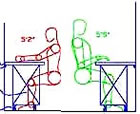 Do you have a body? Does it seem to fit into the world? -at least most of the time. This is because of good ergonomic design. Here is how it's done. (It's a series of drawings as pdf files -give Acrobat a minute to open them. And you will have to use your browser's Go Back button 'cause I don't know how to put links in .pdf's.)
Do you have a body? Does it seem to fit into the world? -at least most of the time. This is because of good ergonomic design. Here is how it's done. (It's a series of drawings as pdf files -give Acrobat a minute to open them. And you will have to use your browser's Go Back button 'cause I don't know how to put links in .pdf's.)
A Design Work-Sheet
 This is literally a cut and paste design worksheet. Print it, cut out the various shapes representing my drawer and display cases, and design your own PERFECT Home-Museum.
This is literally a cut and paste design worksheet. Print it, cut out the various shapes representing my drawer and display cases, and design your own PERFECT Home-Museum.
An Idea Slide-Show
 No words -just pictures of the many possible ways you can get the best possible use from my casework.
No words -just pictures of the many possible ways you can get the best possible use from my casework.
Caring for Collectable Books
 Why, you ask, do I have a link to another web-site here on my table of contents page for How-To articles? Gaylord Brothers has a free on-line book, Book Craft with excellent advice on caring for books ----and books are a very worthy collectable. In fact, if you were to ask me what I collect, I'd have to say I collect books. (And tools, but this is another story.)
Why, you ask, do I have a link to another web-site here on my table of contents page for How-To articles? Gaylord Brothers has a free on-line book, Book Craft with excellent advice on caring for books ----and books are a very worthy collectable. In fact, if you were to ask me what I collect, I'd have to say I collect books. (And tools, but this is another story.)
Why We Collect
I'm particularly proud to be able offer Daniel Arnet's thoughts on Why We Collect. Reprinted with kind permission of the author and Hemispheres -the magazine of United Airlines.
Displaying A Knife Collection:
 In Displaying a Knife Collection, I offered advice on displaying knives on the wall. Nice way to go, but what if you wanted to put them in a display case on the flat, or perhaps one of my coffee table display cases -under glass even? Here is a great technique to display your knives on a flat surface and protect the edges at the same time.
In Displaying a Knife Collection, I offered advice on displaying knives on the wall. Nice way to go, but what if you wanted to put them in a display case on the flat, or perhaps one of my coffee table display cases -under glass even? Here is a great technique to display your knives on a flat surface and protect the edges at the same time.
Using Riker-Mounts Mk II:
 In my original article on Using Riker-Mounts, I dealt with color and light and design and all. But things have to stay where you put them or the design don't amount to diddley. Here's how to put the mount in Riker-mount.
In my original article on Using Riker-Mounts, I dealt with color and light and design and all. But things have to stay where you put them or the design don't amount to diddley. Here's how to put the mount in Riker-mount.
